October 8, 2025
Imagine you are a salmon. You begin in a tiny orange egg buried in the gravel of a cold, clear Oregon stream. After a time, you emerge from your orb as a very small fish called an alevin. You hide from predators amongst the pebbles and live off your attached yolk until you grow into a fry. You are now mighty, stretching a whole one to two inches in length. As a fry, you swim to the surface of the stream, where you gorge yourself on insects and continue to grow, develop spots, and become first a parr and then a smolt. As a smolt, some internal force compels you to swim downstream until you reach the ocean, where your body composition changes from that of a freshwater fish to that of a saltwater one. You grow big and strong over many years by fighting the ocean currents, dodging predators, and feasting on crustaceans, squid, and smaller fish.

Fertilized Chinook salmon eggs. Photo source: Laura Mahoney, U.S. Fish and Wildlife Service

A young Coho salmon. Photo source: Katrina Liebich, U.S. Fish and Wildlife Service
Then something changes. That mysterious force that brought you to the sea calls you home. Using your sense of smell, your lateral lines, and perhaps the geomagnetic forces of the earth, you navigate through several hundred miles of waterway. Human infrastructure has made your daunting voyage even more challenging by putting tremendous pressure on your species and your habitat. Farms, mines, logging, hydroelectric dams, and urbanization have brought sediment to floodplains, contaminated water, cut down old growth forests, and exiled your species from the habitats it needs to spawn.
In addition to facing major existential threats from carbon emissions (which raise the temperature of water, make it more acidic, and decrease its salinity), your species must confront obstacles caused by land use and transportation systems not designed with fish in mind. Too-small culverts, toxic tire additives, and expanses of pavement block off waterways, poison creeks, and erode the streams and wetlands vital for fish survival.

Spawning Coho salmon. Photo source: Roger Tabor, U.S. Fish and Wildlife Service
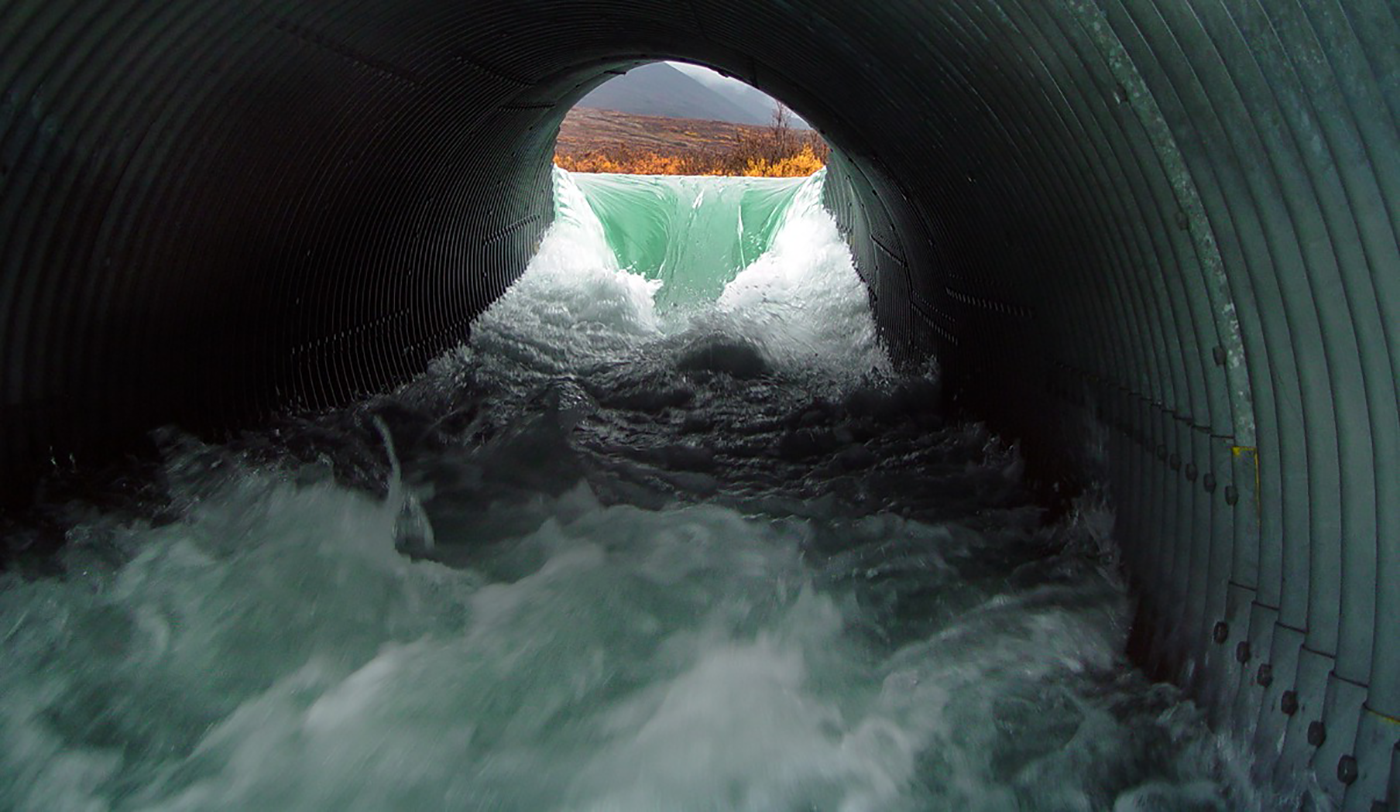
Too-small culverts make fish passage more difficult. Photo source: Alaska State Department of Fish and Game
But you are one of the lucky ones. You persevere, swimming through maze-like fish ladders, leaping up into rushing culvert pipes, and skating across flooded roadways—and you do it all without eating and while undergoing tremendous changes to your body’s color, shape, and chemical makeup.
Once back in your home stream, you use your strong tail to dig your redd. You lay your eggs and guard them for a time. And then you die. As your body decomposes, it returns the nutrients of the sea back to the river and nourishes scavengers, some of whom will go on to feed your young.
This regenerative lifecycle has played out in the Pacific Northwest for millions of years, and transportation professionals have an important role in ensuring it continues.
The Significance of Salmon
Humans and salmon have been in contact for millennia. Mark Kurlansky, author of Salmon: A Fish, the Earth, and the History of Their Common Fate (2020), reminds us that the archaeological record has neanderthals dining on salmon some 48,000 years ago and that we have been trying to protect salmon habitat for thousands of years: the thirteenth century Magna Carta—one of the earliest records of law—has a clause preventing the obstruction of salmon passage. Today in the Pacific Northwest, salmon remain integral to the region’s nature and culture.
Five species of salmon—chinook, chum, sockeye, coho, and pink—and one species of trout—steelhead—call the waters of the Pacific Northwest home. Each of these species is anadromous, meaning its members are born in freshwater, migrate to saltwater, and then return to freshwater to spawn. Pacific salmon and steelhead are keystone species, which means that other species and the larger ecosystem depend on their presence for survival. Adult salmon feed some of our continent’s most impressive fauna: orcas, seals, sharks, and sea lions, as well as bears, wolves, and eagles. Salmon eggs and juvenile salmon feed gulls, kingfishers, terns, and the adorable American dipper, as well as river otters, mink, and ermine.
The migratory fish of the Pacific Northwest also feed economies. From 2012 to 2015, commercial and recreational salmon fisheries in southeast Alaska, British Columbia, Washington, and Oregon added nearly $2.0 billion to GDP and 26,700 full-time-equivalent jobs to the U.S. economy. And in 2021 alone, Oregon’s commercial fisheries added more than $640 million in income to the state economy.
Know Your Pacific Salmon and Steelhead
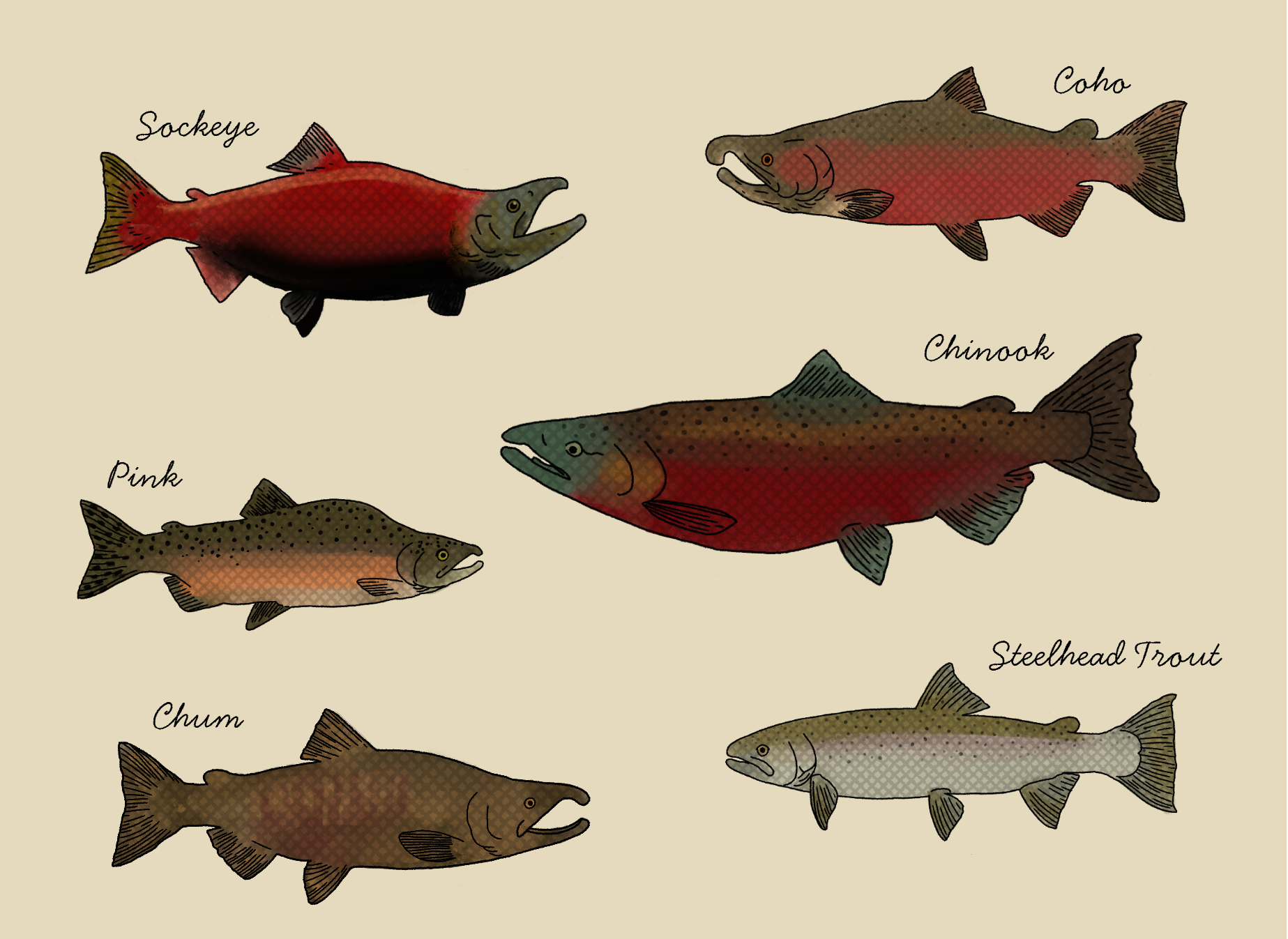
Illustration by Emily Westoby, Kittelson & Associates, Inc.
Salmon are also a cultural keystone species. They are central to the identities, practices, family structures, community cohesion, and ways of life for hundreds of Indigenous peoples in the Pacific Northwest. Salmon are so integral to their physical and spiritual ways of life that these communities often call themselves “Salmon people” or “Salmon nations.”
Salmon—along with big game, roots, and berries—is a First Food, a food that Indigenous ancestors relied upon for community health and survival in the past and that their descendants still rely on for communal wellbeing today. As Emma Johnson (Cowlitz and Norwegian), coordinator of Portland State University’s Indigenous Traditional Ecological and Cultural Knowledge program, explains, salmon peoples had to be experts in salmon behavior and fishery management. “They often used plants like salmonberry to indicate when salmon were running the river and integrated this plant into their stories,” she said. “Salmonberry is usually the first berry of spring. The abundance of the berries told tribes whether it would be a good year for salmon. And where the berries grow along streams provide shade, which is very important for salmon habitat.”
Salmon remains integral to the cultural identities and practices of the Cowlitz and other tribes across the Pacific Northwest. Many continue to hold first salmon ceremonies each year. According to Johnson, in the Cowlitz’s annual first salmon ceremony, tribal members gather on the banks of their ancestral river—the Cowlitz—and await the arrival of their canoe family, tribal members who practice traditional canoe culture. “Rivers were our highways,” Johnson explained. “Canoes were our main source of transportation.” With them, the canoe family carries an important passenger: a salmon on a cedar plank, usually adorned with native plants. Once ashore, the canoe family and the gathered tribal members tell stories about this salmon or others and carry out ceremonies to honor these finned relatives and pray for community health.
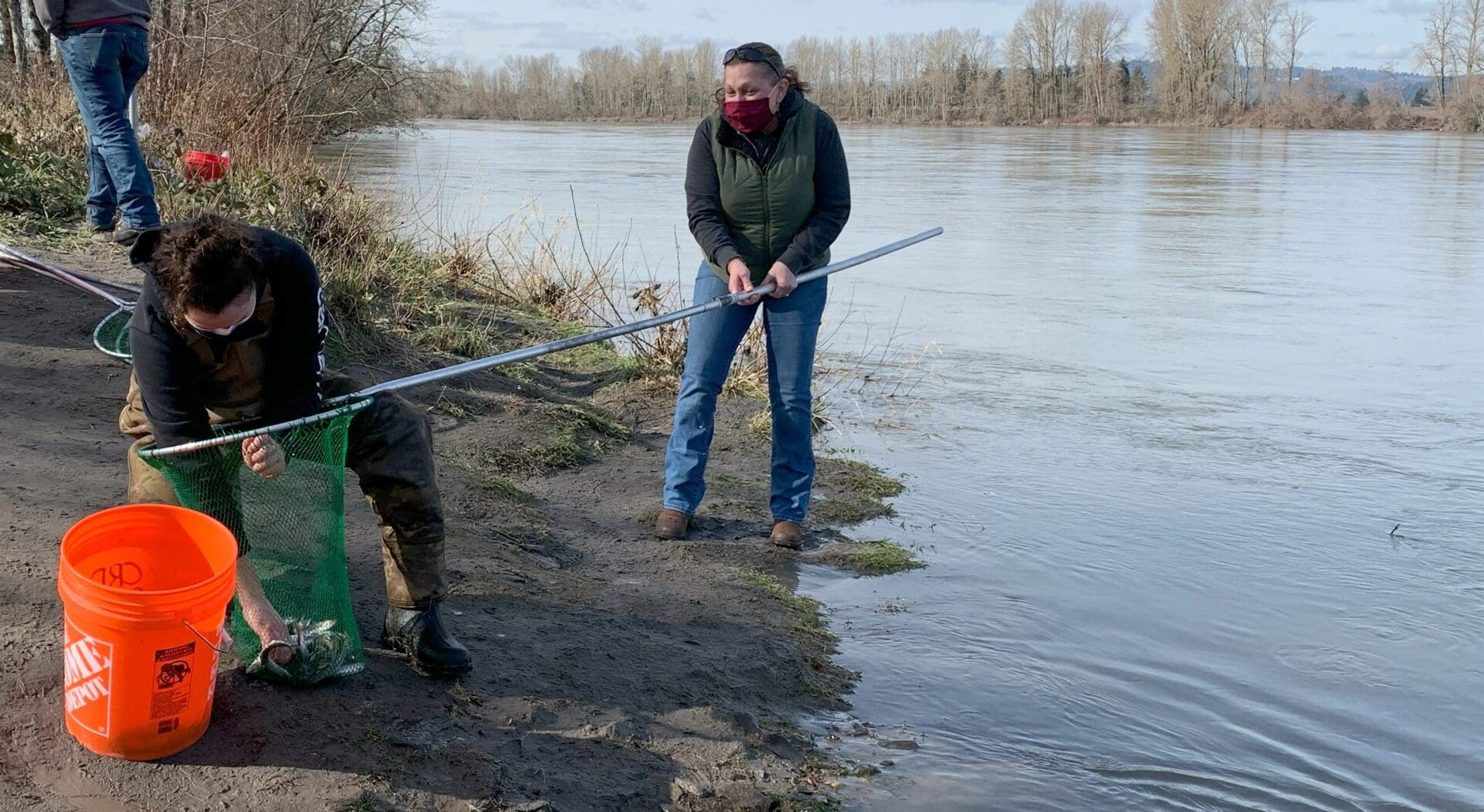
Johnson and her mother Deb Mizner at a cultural smelt dip on the Cowlitz River. Photo Source: Emma Johnson.
The Cowlitz and other salmon peoples are huge advocates for river restoration work. In 2024, the Cowlitz, with National Oceanic Atmospheric Administration Fisheries funding, removed the Kwoneesum Dam on Wildboy Creek, which had blocked upstream salmon and steelhead migration for more than half a century. According to Johnson, salmon habitat restoration like this is a form of ceremony: “You are giving salmon something that they haven’t felt in that section of the river in many years.” Transportation professionals today have an opportunity to give salmon something they haven’t felt in many years: infrastructure that supports rather than thwarts fish passage.
A Closer Look at the Infrastructure Problem
To continue in their important role as a keystone species, salmon and steelhead need access to their spawning and rearing grounds. The ideal salmon stream is cold, with riffles (shallow rocky areas with rough water) to aerate the water and pools to provide shelter for young fish. Trees along the bank prevent erosion and cast shade over the stream, and as the trees die and fall into the water, they provide nursery habitat for young fish. Nearby wetlands are also important because they provide the habitat for the insects and invertebrates that salmon eat. Unfortunately, access to these vital habitats has been increasingly restricted by culverts, tires, and sprawling expanses of pavement.
Culverts
Culverts have an important job: allowing water to pass under roadways. But they are often too small or misalign with how a stream or creek wants to flow. When culverts are too small, water flows too quickly and digs out the creek bed. This process—called scour—erodes the streambed so that the culvert is elevated, with the outflow like a waterfall into the stream below. When swimming upstream, some salmon are strong enough to hurdle themselves up into these culverts and swim through the fast-moving water, but many smaller, weaker fish get left behind. Too-small culverts are also easily plugged with debris, which can block fish passage entirely and flood nearby roadways and properties, causing expensive damage and delay for people.
The best culverts are invisible to fish. To support easy fish passage, the gravel and pebbles of the creek bed should form the bottom of the culvert or the culvert should use a stream simulation channel bottom. The culvert width should exceed the stream width (by at least 50% if salmon are present) and be aligned with the natural course of the waterway. The culvert should have plenty of capacity so that even during times of high flow, there is still room for fish and debris to pass through. Because fish are temperature and light sensitive, the culvert should be shaded but short enough that you can see light on both sides. It’s also crucial to account for the movement of rocks and pebbles over time.
Anatomy of a Fish-Friendly Culvert
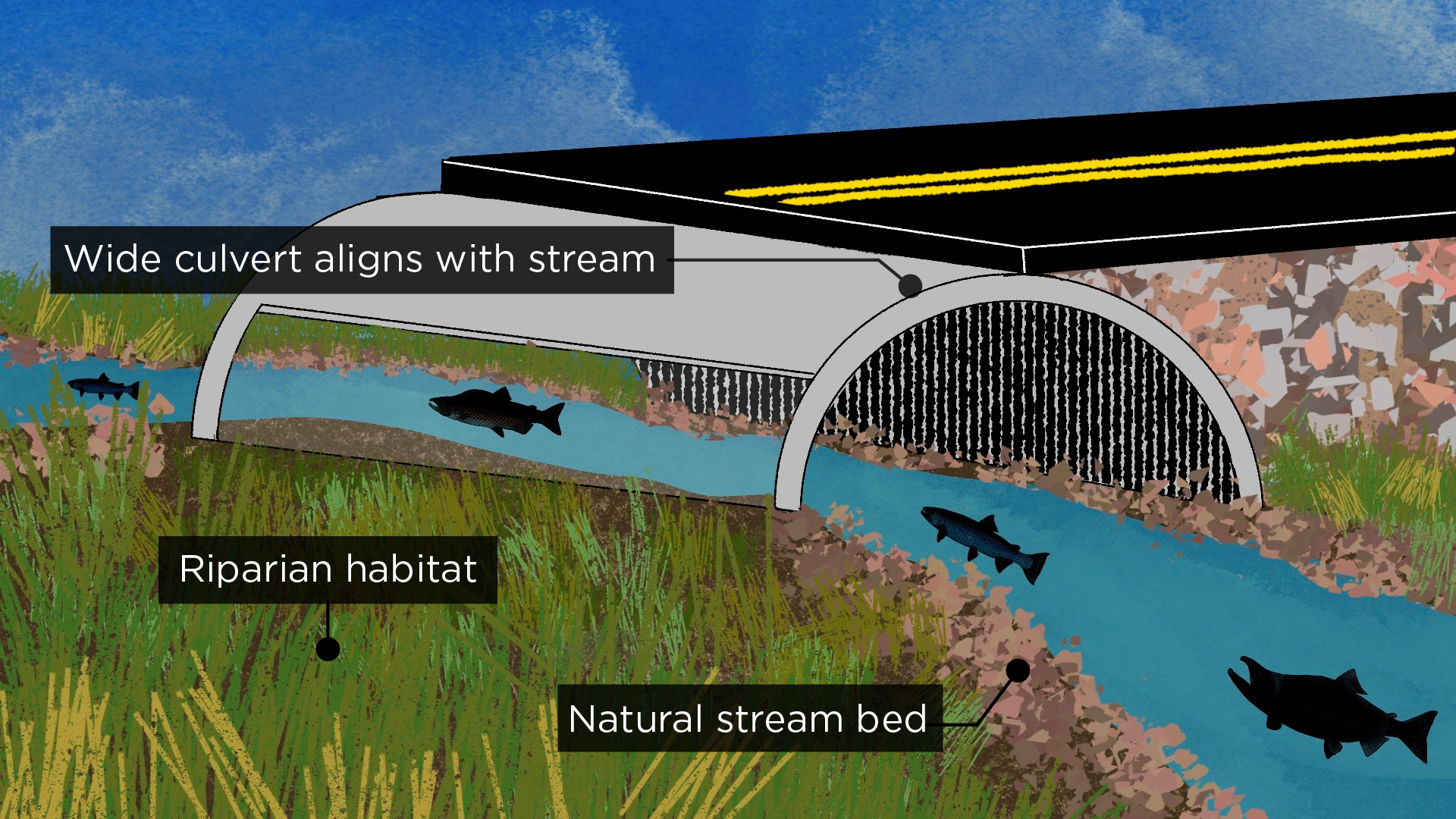
Illustration by Emily Westoby, Kittelson & Associates, Inc.
In 2021, we had the opportunity to help Washington County, Oregon replace a too-small culvert with one that is just right. Sullivan Road winds through a rural forest off U.S. Highway 26, and Burgholzer Creek quietly flows underneath. Identified as a high priority for fish passage in a local watershed assessment, the culvert along Burgholzer Creek needed some serious work. Over time, the culvert had started to wash out, its bottom was rusted, and it perched nearly three feet above the creekbed. Siltation and fast-moving water were making passage more difficult for fish, and many migrating salmon were effectively cut off from their upstream habitat. And it wasn’t working much better for people: no vehicle wider than a four-wheeler was able to use the road because sinkholes had started to appear along the roadway.
To help, the project team installed a wider, structural steel arch culvert on precast concrete footings over the creek bed. And as Stephen Cruise, project manager for Washington County, explained, the team realigned the culvert so that rather than being perpendicular to the roadway like most culverts, the culvert angled along the natural path of the stream. The team also installed buried trees with their root balls exposed to help slow down the water and guide it through the culvert. Since the culvert’s replacement, coho salmon have been spotted upstream. “Nature is resilient,” Cruise said. “Once you open up the stream and restore the stream functions with a wider culvert, fish want to get through as soon as possible.”
Burgholzer Creek Before
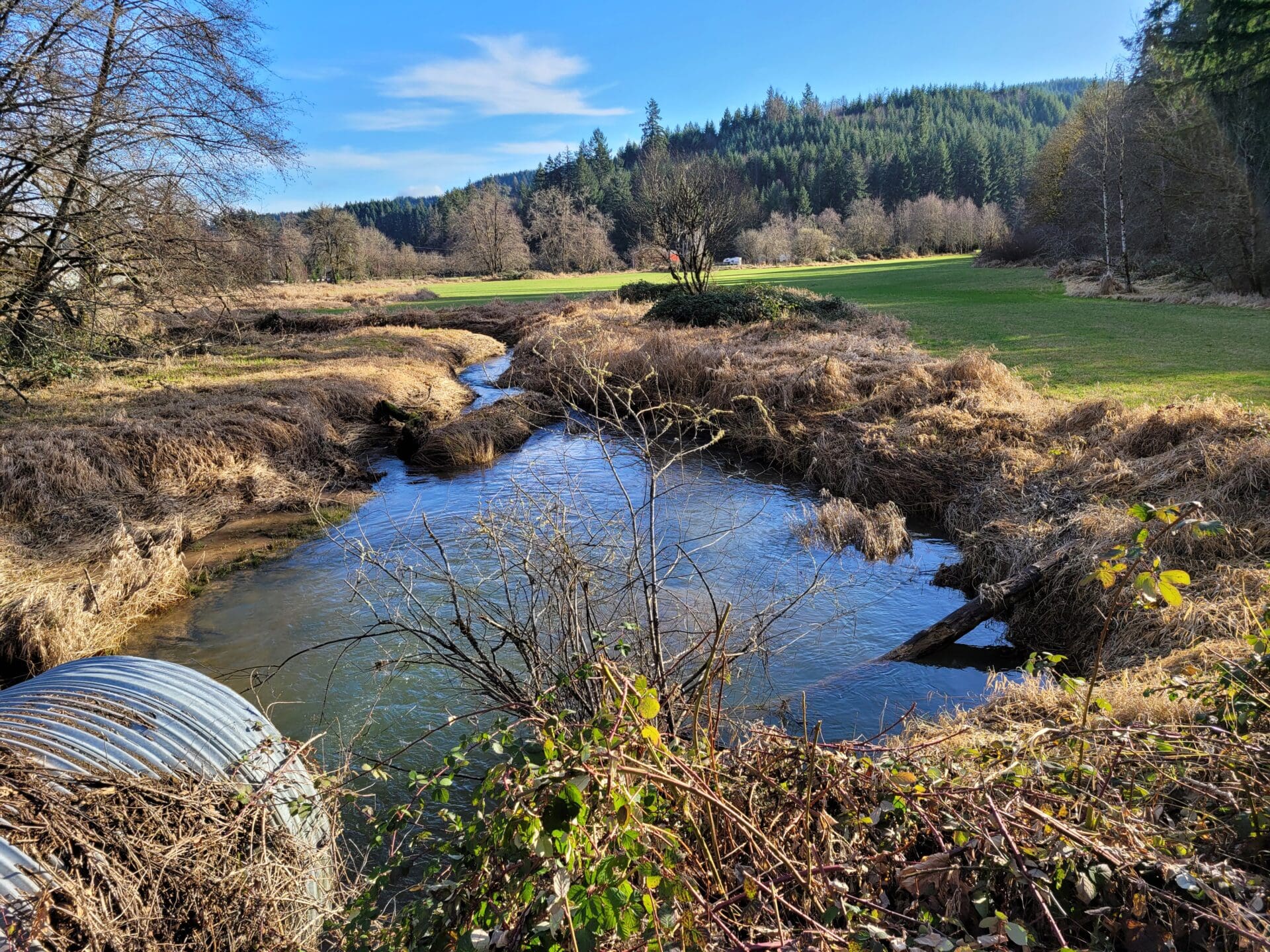
The original culvert was too small and perched almost three feet above the creekbed. This widened area near the outlet was a deep hole, scoured from forceful output. Note also the sediment pile that had accumulated where the stream narrowed. Photo source: Kittelson & Associates, Inc.
Burgholzer Creek After
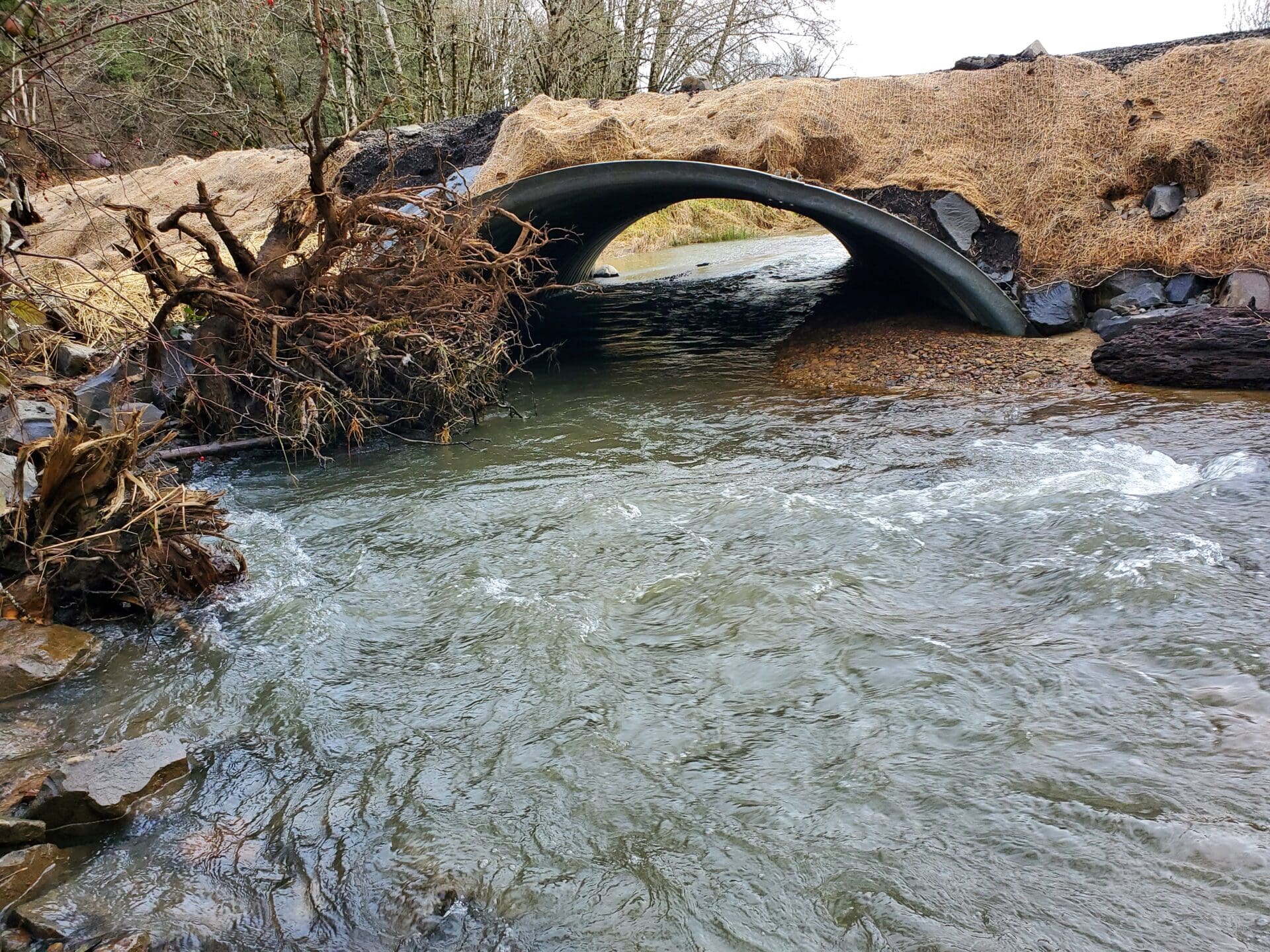
The new culvert is much wider and uses the creek bed as its bottom. Root balls and buried trees to the left of the inlet help the rapidly moving water slow down and make a gentler turn into and through the culvert. Decreasing the velocity of the water also helps preserve the rocks and pebbles that you can see along the right bank and prevents scour. Photo source: Kittelson & Associates, Inc.
Tires
For more than two decades, Washington State saw generations of coho salmon mysteriously die before they could lay their eggs in the rivers and streams near Puget Sound. In 2020, researchers discovered the cause: 6PPD-quinone, a chemical created when tires react to ozone. The molecule is fatal to coho salmon at amounts less than one microgram per liter of water. Without stormwater management, these toxic tire particles wash directly into rivers and streams.
To manage 6PPD-quinone, the Washington State Department of Ecology recommends:
- Sweeping streets and roofs to control the accumulation of particulates. (Recycled tires are often used for the flat roofs of commercial buildings.)
- Holding water in ponds, infiltration basins, and bioretention facilities to slow runoff and reduce runoff volumes.
- Using biofiltration swales, bioretention facilities, and manufactured treatment devices to physically filter or chemically sorption stormwater.
To read more about retention facilities and bioswales, check out our article on stormwater management and green infrastructure.
Impervious Surfaces
Because they prevent rainwater from directly accessing soil and plants, large impervious surfaces like parking lots and roadways exacerbate pollution issues from runoff.
The larger the untreated and unmanaged impervious area, the worse its impact on water quality and fish habitat. These surfaces increase stormwater flows from urban development, which changes the hydrologic patterns of nearby watersheds in a process called hydromodification. As they tear through waterways, these increased flows erode streambanks, which mixes extra sediment into the water. Over time, these streams and rivers become shallower and wider and therefore warmer, slower, and more hostile to fish and other wildlife. Salmon and steelhead are tenacious, but when flood erosion that you’d expect to happen once every few years starts happening many times each winter as a result of development, stream viability becomes compromised.
Low-impact development (LID) gets ahead of these problems. LID mimics a site’s natural hydrology by minimizing impervious surfaces and then infiltrating, filtering, storing, evaporating, and detaining stormwater runoff. Preserving undeveloped open spaces like parks and installing rain gardens, green roofs, permeable pavement, bioswales, and biofiltration facilities can help tremendously. Some of the best LID you can get comes from natural systems. Often, nature is as good or even better than people at managing water. For example, on the Florida coast, planners are turning to hybrid solutions that use both seawalls and mangroves to manage storm surges. For more on managing water on roads—including how the humble beaver might be a better water quality manager than a multimillion dollar engineered wetland—check out our article Slippery When Wet: How Water Impacts Roadways and What We Can Do About It.
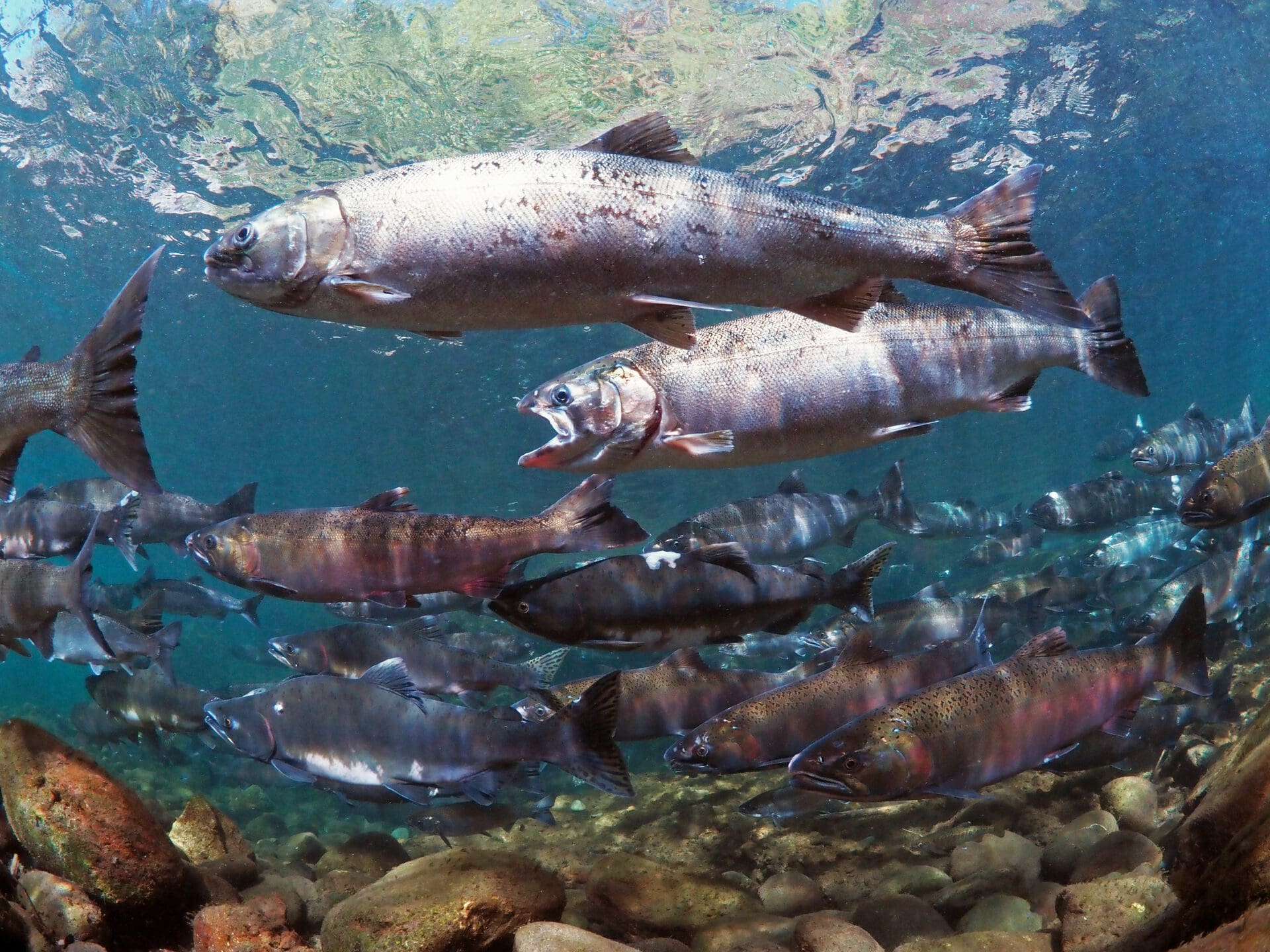
Roadway improvements that support fish passage and water quality likewise benefit human mobility.
What’s Good for Fish Is Good for People
For some, regulations for water quality and fish passage can feel onerous, like more red tape in an already complicated regulatory environment. However, improving fish habitat often comes with human benefits. According to a U.S. Fish and Wildlife Service report, projects that remove barriers to fish passage offer numerous financial and quality-of-life benefits to human communities. Barrier removal can:
- Support public safety by removing aging dams and spillways that create drowning risks to residents and visitors.
- Boost recreation by creating new kayaking, boating, swimming, and angling opportunities.
- Repair cultural relationships by returning habitats to natural conditions.
- Bolster flood resistance by replacing undersized culverts, which are prone to clogging with debris.
- Improve water quality by reducing altered flows and sediment accumulation.
Roadway improvements that support fish passage and water quality likewise benefit human mobility. For example, planters and rain gardens reduce impervious surfaces, slow traffic, and support community placemaking. Plus, LID can reduce the need for detention ponds and flood controls (which take up a lot of real estate) and reduce costs associated with grading, landscaping, paving, and infrastructure like pipes, curbs, and catch basins.
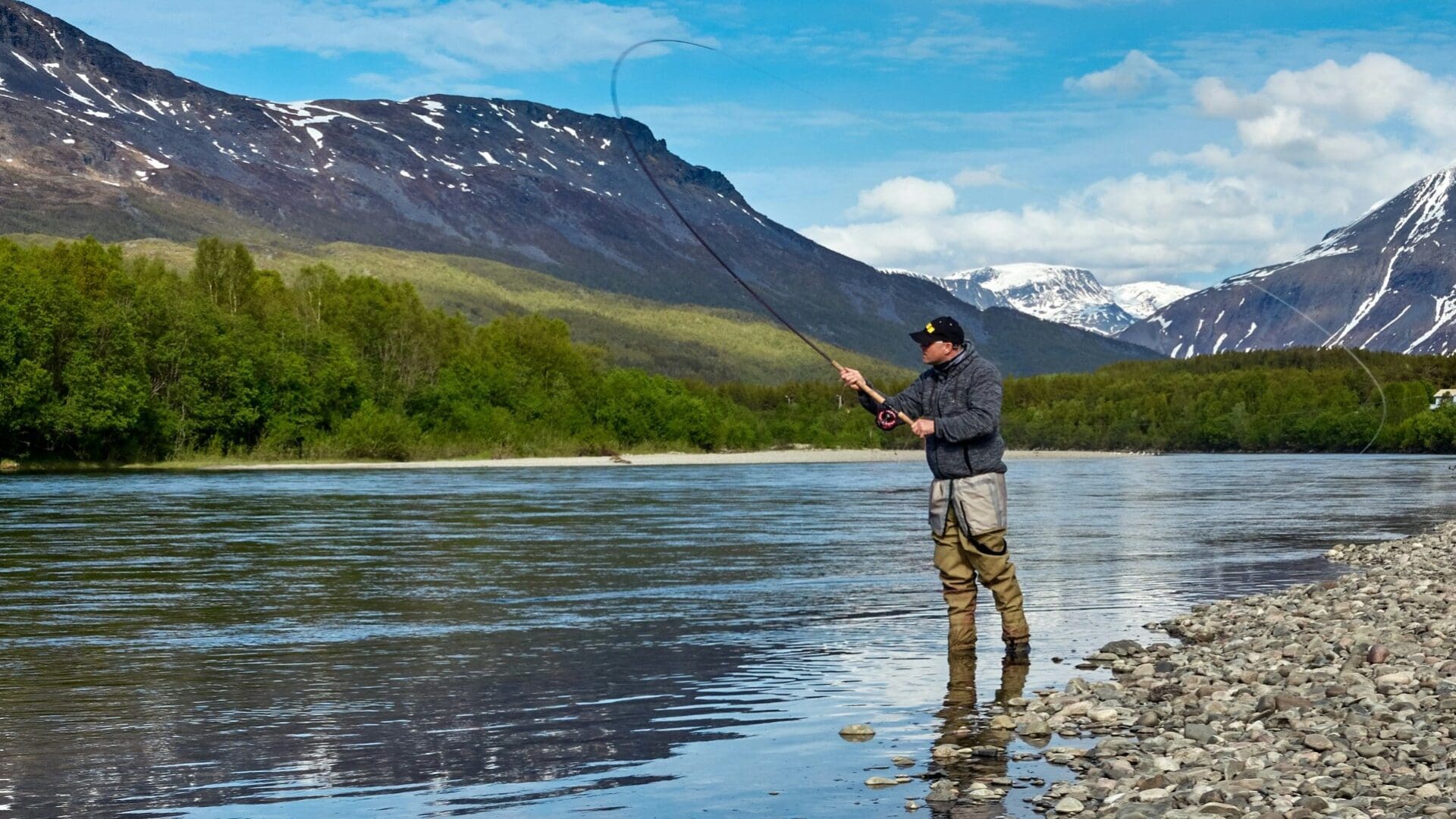
Improving fish habitat often comes with human benefits, like boosted recreation from new kayaking, boating, swimming, and angling opportunities.
How to Help
Culvert and stormwater experts aren’t the only people with the capacity to restore fish passage. You can help by:
- Thinking with your stomach. Consider how the work you are doing will ultimately impact what you order at a restaurant. We don’t catch salmon in the small local creek that borders a suburban neighborhood, we catch them in the ocean or in the big regional river. But those same salmon that end up on your dinner plate begin their lives in that little neighborhood creek and must return there to keep their species going. As a result, any roadway improvements you make to that neighborhood street will affect those fish—and your dinner.
- Considering stormwater. Traditionally, transportation planning and stormwater management were separate processes. By thinking about how we can move water along a project area before getting deep into the project process maximizes our ability to shape the future of an area and its ecosystems. Thinking through what you are going to do with all the rain—because it does rain everywhere, even in the driest place on earth—early on means that you might be able to add planters along the corridor and avoid an expensive retrofit later or a long, expensive process to get land for a pond. Planning ahead also allows you to develop realistic cost estimates for stormwater facilities and culvert replacements so that price tags don’t become a reason to delay a project.
- Reducing impervious surfaces when possible. Minimizing impervious surfaces and maximizing planted areas decreases runoff and helps reduce urban heat island effects. When planning paved surfaces, consider the minimum width that will meet users’ needs and the needs of the local watershed. Where possible, consider parking management strategies to reduce the need for paved parking spaces, pervious pavers to increase the amount of water a path can take in, and planters and rain gardens to collect and treat runoff. Remember that the less area you have to pave, the less you have to spend on paving!
- Striving to exceed the minimum standard. Because transportation planners and engineers work on streets—some of our environment’s largest impervious surfaces—we have an opportunity to maximize the good we can do for a community’s human and non-human residents and visitors. While you should be sure to meet the standards given by local regulatory authorities, you might also consider how to go above and beyond to improve water quality and educate partners. Exceeding standards today can also help insulate an area against an expensive retrofit later if standards evolve and set up future projects to benefit from a bigger, better stormwater system.
- Building relationships with regulators. As Cruise recommends, “Getting regulators out into the field to showcase that what you are doing meets their requirements builds trust and confidence in your work. So that when an emergency happens—like a culvert washes out or a bank needs urgent stabilization—regulators know you are prepared and understand what procedures to follow. Having a site visit with regulators before you submit a permit also gives those authorities time to ask questions, identify any concerns, and get a feel for your proposed changes. According to Cruise, strong relationships with agencies like the Oregon Department of Fish and Wildlife and local watershed councils have helped the County fast-track culvert replacements and access funding sources.
- Connecting with your local food systems. Most consumers are disconnected from where their food really comes from. Johnson recommends learning where your fish—or really any food item—comes from. Do you have the means to be more connected with that source? Maybe you can buy your fish from tribal fisheries or your produce from local farms instead of the grocery store. Johnson encourages starting small: even just growing rosemary on your apartment patio represents a way to uplift your community’s relationship with its food system. Just be sure to recognize who these plants and animals are and where they come from, and to share that information with others.
The Way Forward
The animals with whom we share our planet are remarkably resilient. Fish and other aquatic species sometimes appear mere minutes after a dam is removed or a culvert is replaced. But time is of the essence. To be able to swiftly reappear in these habitats, these animals need to still exist.
The problems faced by salmon and other anadromous fish today are not unlike those they faced from DDT in the 1960s. But as Rachel Carson reminds us in Silent Spring, her 1962 exposé about DDT’s impact on wildlife, all hope is not lost: “To assume that we must resign ourselves to turning our waterways into rivers of death is to follow the counsel of despair and defeatism. We must make wider use of alternative methods that are now known, and we must devote our ingenuity and resources to developing others.”
Johnson echoes Carson’s call for hope. “Salmon could use everybody. It’s not a matter of if you are the right person. If you can know and understand who salmon are, they can benefit from whatever support you have to give.”
Today, tribes, agencies, and companies throughout the Pacific Northwest, including Kittelson, are answering the call, working with ingenuity and resources—and hope—to set policy, seek funding, and deliver projects that improve salmon habitat and passage. If you are ready to improve the rivers in your community, we’re here to help.
